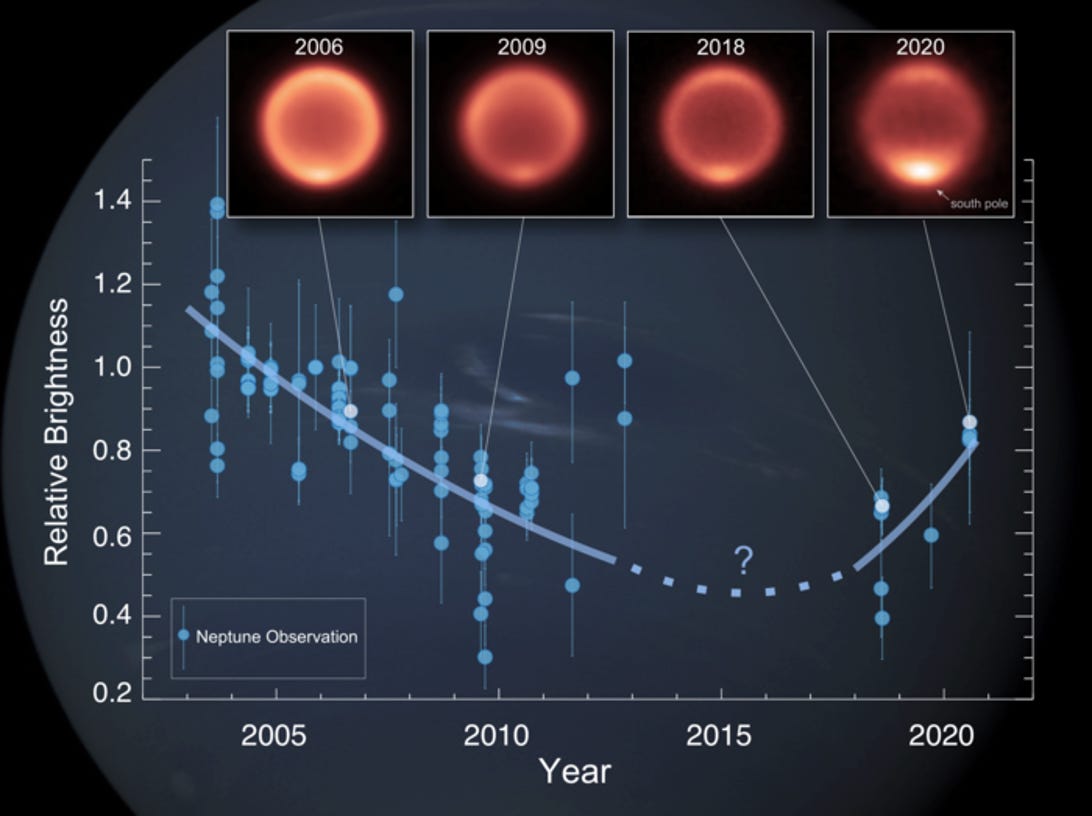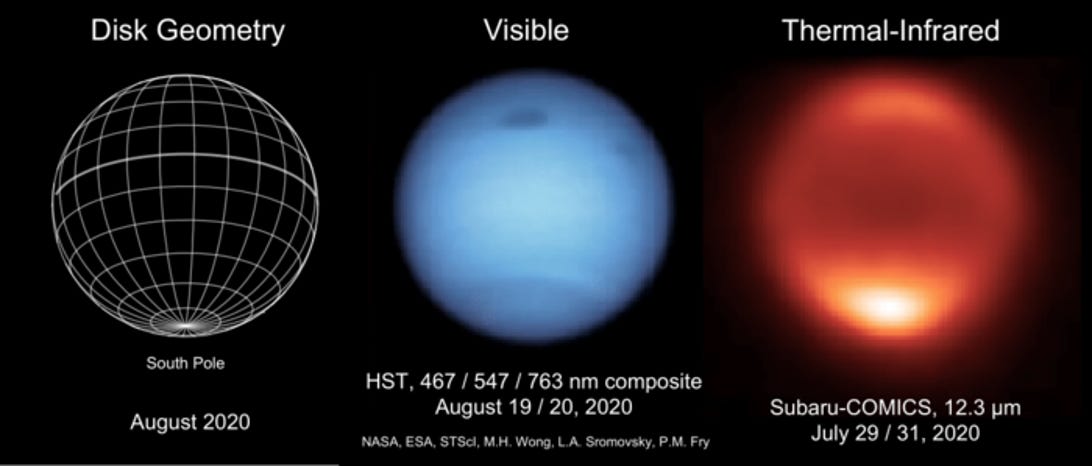

Voyager 2 view of Neptune, captured in August 1989.
NASA/JPL-Caltech/Kevin M. Gill
Some 2.7 billion miles from Earth, the south side of Neptune is in the midst of summer. But it isn’t the kind of summer we’re used to.
Neptune takes around 165 Earth years to finish an orbit around the sun, which means its seasons each dawdle on for 40 such years. That’s about 160 times longer than one of our seasons, and according to new research published Monday in the journal Planetary Science, this isn’t even the strangest part.
Unlike our home planet — which heats up in the summertime for picnic days and beach escapades — the azure world seems to be… cooling down?
“This change was unexpected,” Michel Roman, a researcher at the University of Leicester and lead author of the study, said in a statement. “Since we have been observing Neptune during its early southern summer, we would expect temperatures to be slowly growing warmer, not colder.”
The surprising find comes after an international team of researchers combined two decades’ worth of infrared images depicting Neptune, collected by super powerful telescopes like the European Southern Observatory’s Very Large Telescope. Basically, these images can tell what the planet’s thermal conditions are based on how bright it is. Brighter means hotter.
After checking out the datasets, the team clearly found Neptune’s thermal brightness declining in its stratosphere between 2003 and 2018, during the planet’s first whispers of summer. Put together, that adds up to a roughly 8 degrees Celsius drop in temperature, the study says.

The plot shows the relative change in the thermal-infrared brightness from Neptune’s stratosphere with time for all existing images taken by ground-based telescopes. Brighter images are interpreted as warmer.
Michael Roman/NASA/JPL/Voyager-ISS/Justin Cowart
But here’s where things get even weirder.
Down at the south pole of Neptune, the researchers saw the planet warming between 2018 and 2020, something they say hasn’t ever been seen before at the windy orb’s poles. (I say windy, because Neptune’s winds are so utterly fast they’re considered supersonic, aka faster than the speed of sound). “Our data covers less than half of a Neptune season, so no one was expecting to see large and rapid changes,” Roman said.

Neptune as seen in visible light (center) and thermal-infrared wavelengths (right), in 2020. In the thermal-infrared, Neptune’s warm south pole glows more brightly than ever seen before.
Michael Roman/NASA/ESA/STSci/M.H. Wong/L.A. Sromovsky/P.M. Fry
However, Roman does offer a few ideas for Neptune’s summertime temperature confusion.
“Temperature variations may be related to seasonal changes in Neptune’s atmospheric chemistry, which can alter how effectively the atmosphere cools,” Roman said. “But random variability in weather patterns, or even a response to the 11-year solar activity cycle may also have an effect.”
In other words, it’s possible that Neptune’s thermal shenanigans could technically be happening because of sheer coincidence, periodic variation in the sun’s activity or even changes surrounding our host star’s sunspots, where magnetic fields are unimaginably strong – like, over 2,000 times that of Earth’s.
The researchers also suggest general stratospheric changes, or maybe just the number of bright clouds floating around Neptune might have made the blue gas giant’s thermal brightness alter unexpectedly. But for now, these options are all very theoretical.
Though excitingly, such speculation may soon be put to rest because of… drum roll please… the recently launched James Webb Space Telescope. It has exactly what we need in our arsenal to decode Neptune’s seasonal truth. It’s stuffed to the brim with infrared imaging equipment precise and strong enough to peer into the deepest, darkest, most elusive regions of space.

This artist’s concept shows the James Webb Space Telescope.
NASA
“The exquisite sensitivity of the space telescope’s mid-infrared instrument, MIRI, will provide unprecedented new maps of the chemistry and temperatures in Neptune’s atmosphere, helping to better identify the nature of these recent changes,” Leigh Fletcher, a planetary scientist at the University of Leicester and co-author of the study, said in a statement.
Time for us to add yet another awesome puzzle to Webb’s continuously compounding task list that already includes studying things like the farthest star we’ve ever detected and exploring new avenues in pursuit of finding alien life.